Viña Koyle has always offered delicious wine at a fair price. But now they are much more than that. They produced wines that clearly represent their specific parcel of land in Chile’s Colchagua Valley
Viewing entries in
Cabernet Franc
Someone has to be the best right? Loaded question I know. But I’m here to tell you that Smith-Madrone, located on Spring Mountain, is Napa Valley’s Best Winery.
Normal will return, at some point. Perhaps slower than we all want, and not all at once, but it’s going to happen. When it does, look out! Many of us are going to bust out of our shelters and drive, fly, train or hitchhike somewhere we love. One of the places I’m chomping at the bit to return to is Dry Creek Valley
few things tie this group of wines together. First and most importantly they’re delicious. They’re all appropriate for Spring. Regardless of their price point they represent excellent or better value. And finally with just a couple of exceptions, most of them are widely available on store shelves. All of them can certainly be ordered online, which is where many of us are purchasing our wine these days.
The Kautz Family has been involved in the wine business since planting their first vineyards in 1968. Over a couple of decades their plantings expanded to over 5,000 acres between Lodi and the Sierra Foothills. Today they have more than 6,000 acres and they’re a second generation winery. In addition to the Ironstone range of wines they also produce a line of value driven offerings called Leaping Horse.
Today I’m taking a look at two of their wines.
Ironstone 2017 Cabernet Franc $14
Ironstone 2016 Reserve Old Vine Zinfandel $25
Click below to hear all about them and keep in mind they’re just the tip of the iceberg of what Ironstone produces.
Wines are available to order through Family Wineries Direct
The Holidays aren’t almost here, they’re here, NOW! And if you’re like most people there are a handful of loved ones that you still need to buy a gift for. The good news is there’s still time to get them a nice bottle of wine. Just because it’s last minute, that doesn’t mean you shouldn’t put thought into it.
It’s been roughly 20 years’ time since South Africa became part of the Global Wine Community once again. In those two decades the quality of wines has increased and there have been great strides in the South African Wine Industry. Among the many other things that have changed, the number of Women winemakers has increased. And while the increase in diversity alone is cause for celebration that’s just a sliver of what’s happening.
Château La Lauzette is one of a growing number of wineries in the Cru Bourgeois du Médoc that is owned or run by women. This in a region who the average wine lover tends to believe the Château’s are passed down from Father to son from one generation to the next. This particular winery is run by Liz Roskam and her husband Franz. She’s originally from Illinois and relocated to Bordeaux in 2002. They took over the vineyard in 2005.
Château La Lauzette 2010 La Lauzette Declercq, Haut- Médoc, Cru Bourgeois ($30)
This Bordeaux blend combines Cabernet Sauvignon (70%), Merlot (28%), and Cabernet Franc (2%). Aging took place over 12 months in French oak; 33% of the barrels utilized were new. 3,500 cases of this offering were produced. Bits of toast and black raspberry aromas are present on the welcoming nose. The palate is stuffed with a bevy of fruit flavors including cherry, black currant, and dried black fruits. In addition savory herbs such as sage and thyme are also in play. Bits of red fruit, black tea, earth, minerals and chicory are all present on the above average finish. Approachable tannins and firm acid help provide fine structure upon which all of that fruit is built. This is a restrained, elegant and lovely wine that is counterbalanced by plenty of eager fruit flavors. In short it should satisfy wine lovers with a variety of different palates. While this offering was great sipped alone it really stood out with food. I paired it with a burger topped with Smoked Gouda, caramelized onions and a side of rosemary roasted potatoes, which was a fantastic match.
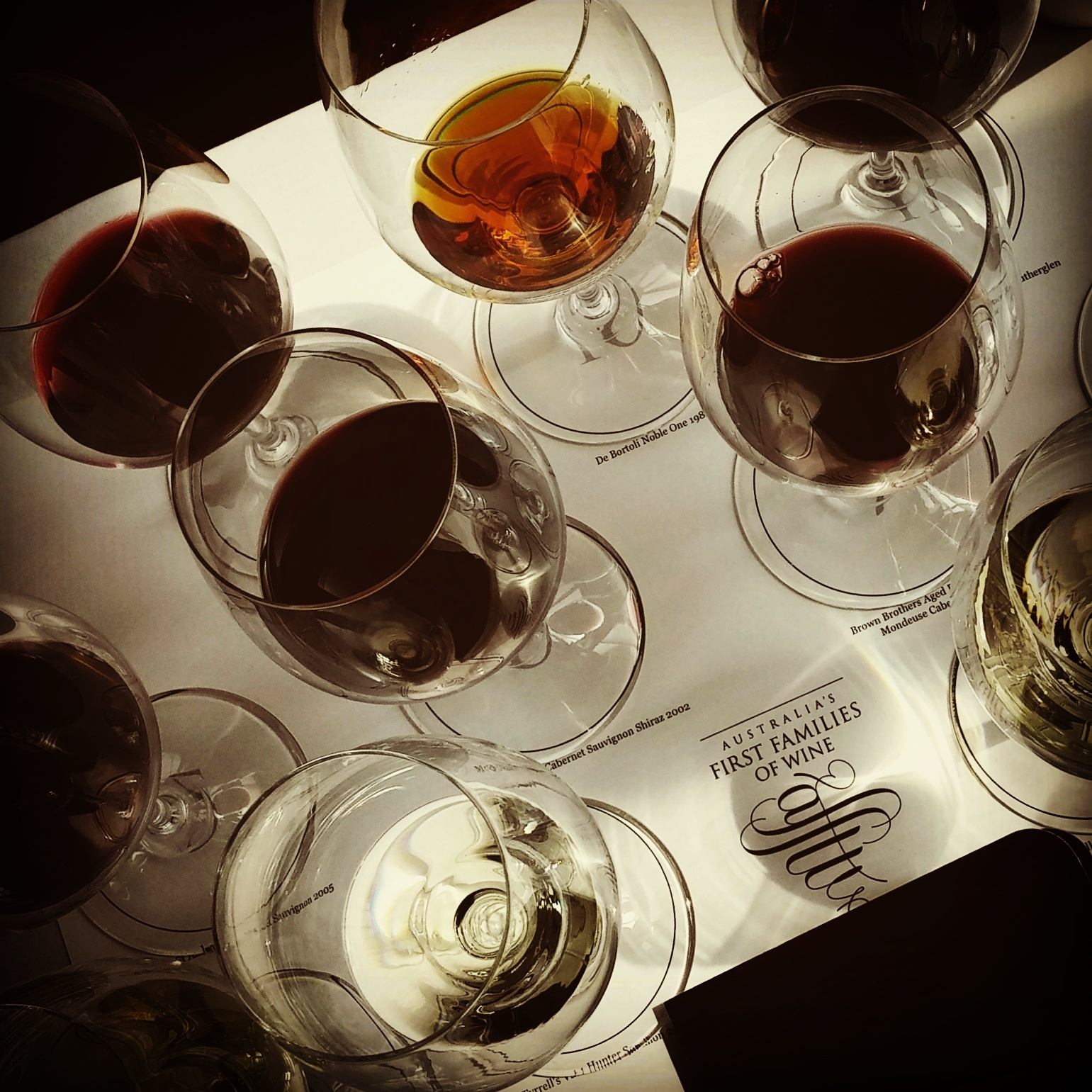 A few weeks back I attended an Australian wine event in Manhattan. This particular tasting was an interesting one indeed. Some of the country’s leading family-owned and multi-generational producers selected wines from their libraries to showcase to American trade and media. The main portion of the tasting was a sit-down seminar led by Mark Davidson, Australia’s worldwide wine educator. Alongside him, family members from each winery whose offerings were being poured that day were on hand to speak about their wine and Australia in general.
There are a couple of general misconceptions floating around about Australian wine. One is that the country’s producers make big, blustery wines that are long on upfront fruit and flash and short on finish and substance. The other is that that Australian wines don’t age. The problem is neither point is really valid; certainly not as wholesale
A few weeks back I attended an Australian wine event in Manhattan. This particular tasting was an interesting one indeed. Some of the country’s leading family-owned and multi-generational producers selected wines from their libraries to showcase to American trade and media. The main portion of the tasting was a sit-down seminar led by Mark Davidson, Australia’s worldwide wine educator. Alongside him, family members from each winery whose offerings were being poured that day were on hand to speak about their wine and Australia in general.
There are a couple of general misconceptions floating around about Australian wine. One is that the country’s producers make big, blustery wines that are long on upfront fruit and flash and short on finish and substance. The other is that that Australian wines don’t age. The problem is neither point is really valid; certainly not as wholesale  statements. Every wine-producing country has great, good, and bad producers. Certainly, Australia still has some who make boatloads of overripe shiraz. However, there are many more making proportionate shiraz as well as a very wide range of other offerings. It’s time to realize that there are as many diverse styles coming out of Australia as any other wine-making country. Not to mention much, much more than just shiraz, no matter how tasty it can be. Head Over to The Daily Meal to read the rest.
statements. Every wine-producing country has great, good, and bad producers. Certainly, Australia still has some who make boatloads of overripe shiraz. However, there are many more making proportionate shiraz as well as a very wide range of other offerings. It’s time to realize that there are as many diverse styles coming out of Australia as any other wine-making country. Not to mention much, much more than just shiraz, no matter how tasty it can be. Head Over to The Daily Meal to read the rest.

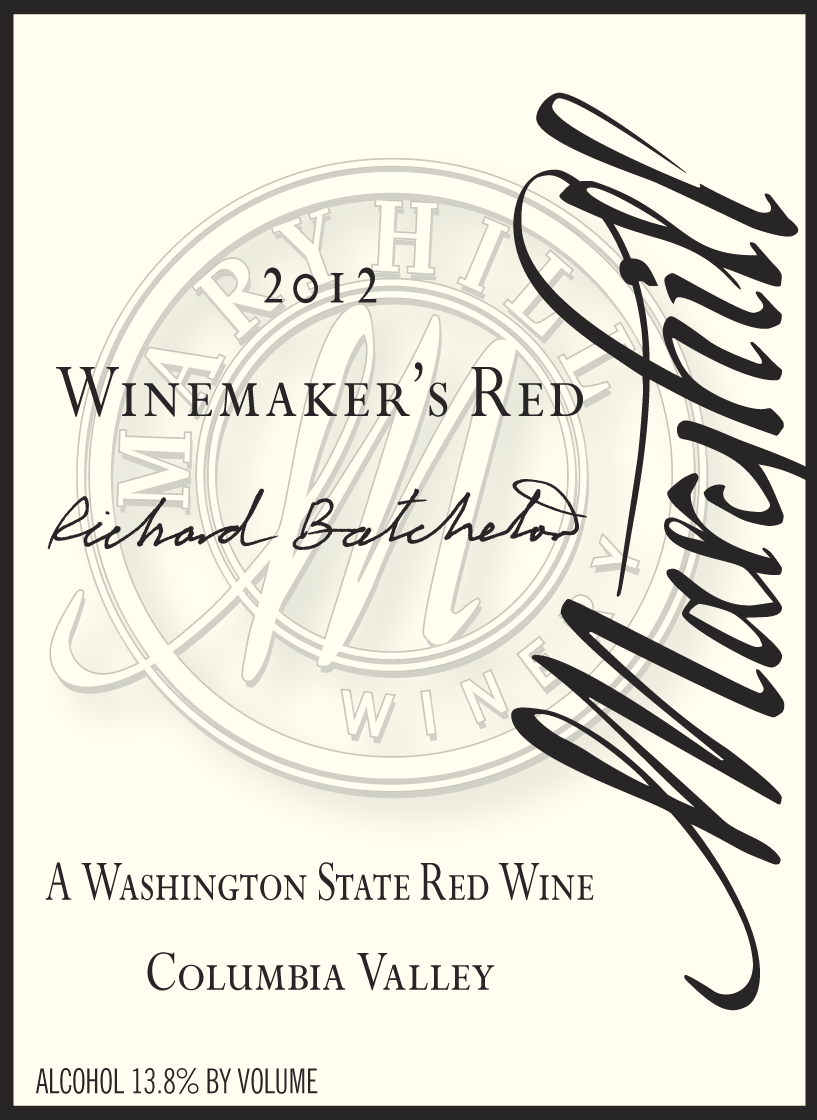 Founded in 1999, Maryhill Winery produces more than 80,000 cases of wine annually. To produce those wines, they source fruit from eight different growing regions and work closely with a dozen growers. That allows them to have a portfolio of offerings that are diverse both in style, intent, and price point. Craig and Vicki Leuthold founded and still own this family business. Their wines are available throughout the country. Maryhill Winery itself is located on the Columbia River in Goldendale and has become a go-to destination, drawing more than 75,000 visitors per year. I just sat down and tasted through a handful of their wines and found a lot to like.
Maryhill Winery 2012 Winemaker’s Red ($15)
Founded in 1999, Maryhill Winery produces more than 80,000 cases of wine annually. To produce those wines, they source fruit from eight different growing regions and work closely with a dozen growers. That allows them to have a portfolio of offerings that are diverse both in style, intent, and price point. Craig and Vicki Leuthold founded and still own this family business. Their wines are available throughout the country. Maryhill Winery itself is located on the Columbia River in Goldendale and has become a go-to destination, drawing more than 75,000 visitors per year. I just sat down and tasted through a handful of their wines and found a lot to like.
Maryhill Winery 2012 Winemaker’s Red ($15)
This offering is a blend of cabernet sauvignon, merlot, syrah, and cabernet franc. Fruit was sourced across numerous Washington state regions. Aging took place in tank, using oak staves over a period of 11 months. Booming cherry aromas burst from the nose of this red; a bit of leather provides a lovely aromatic counterpoint. The extremely appealing palate is loaded with a plethora of sweet but proportionate red and...Head over to The Daily Meal to read the rest.

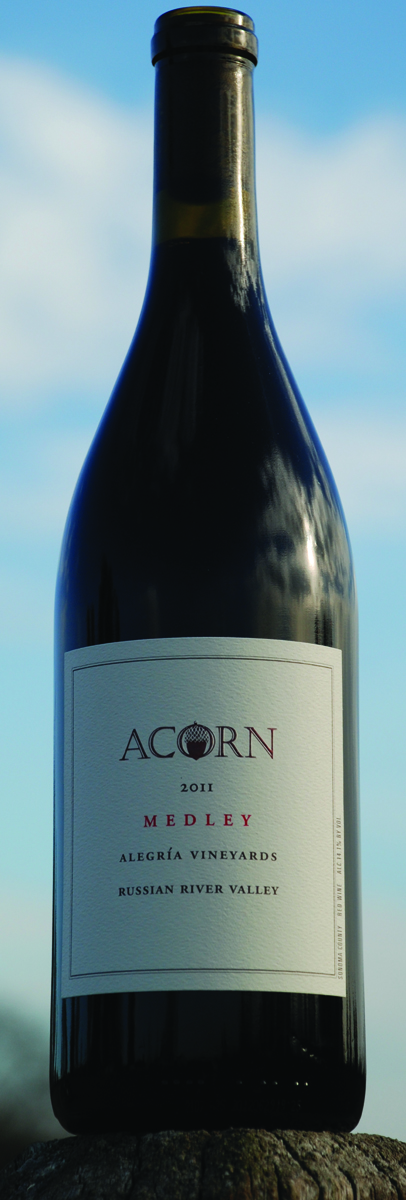 Acorn Winery is a labor of love for owners Betsy and Bill Nachbaur. They’ve been farming their property, Alegría Vineyards, sustainably since 1990. On their 32 acres in Russian River Valley, they grow 60 grape varieties. From that they bottle approximately 3,000 cases of wine each year; every one of them field blends. Their commitment to environmentally sound practices even includes doing away with foil capsules on the bottle. I’ve been a fan of what they do for years now and try to visit them whenever I can. I was out in Sonoma County recently and I spent some time with them, chatting and of course tasting through their latest releases. Head over to The Daily Meal to read the rest.
Acorn Winery is a labor of love for owners Betsy and Bill Nachbaur. They’ve been farming their property, Alegría Vineyards, sustainably since 1990. On their 32 acres in Russian River Valley, they grow 60 grape varieties. From that they bottle approximately 3,000 cases of wine each year; every one of them field blends. Their commitment to environmentally sound practices even includes doing away with foil capsules on the bottle. I’ve been a fan of what they do for years now and try to visit them whenever I can. I was out in Sonoma County recently and I spent some time with them, chatting and of course tasting through their latest releases. Head over to The Daily Meal to read the rest.

 If you’re not sure what to get someone as a gift this year, consider a good bottle of wine or spirits —‚ always in season. Anyone who drinks alcohol will certainly appreciate a well-chosen bottle to enjoy, be it alone or with friends (my hope is that it’s with you). Throughout the year, I’ve tasted a number of the best bottles in both the wine and spirit categories and compiled a list of my 24 favorites — any of which would make excellent gifts for a variety of budgets. A few of the bottles are particularly great values, while others are luxury beverages that will really impress the lucky person who receives them; no matter the price, every selection in this guide is delicious and well made. Head over to The Daily Meal to read the rest.
If you’re not sure what to get someone as a gift this year, consider a good bottle of wine or spirits —‚ always in season. Anyone who drinks alcohol will certainly appreciate a well-chosen bottle to enjoy, be it alone or with friends (my hope is that it’s with you). Throughout the year, I’ve tasted a number of the best bottles in both the wine and spirit categories and compiled a list of my 24 favorites — any of which would make excellent gifts for a variety of budgets. A few of the bottles are particularly great values, while others are luxury beverages that will really impress the lucky person who receives them; no matter the price, every selection in this guide is delicious and well made. Head over to The Daily Meal to read the rest.
 One of my favorite things about covering wine is the opportunity to hang out with winemakers. It’s a lot of fun and also a relief when there’s someone in the room who’s more of a geek about fermented grape juice than I am. The last few years I’ve been really impressed with the offerings being put out by Trione Vineyards & Winery. And while I’ve loved the wines, it was only recently that I visited their tasting room and met their winemaker Scot Covington. I spent most of an afternoon with him and we tasted wines in barrel, tank and of course out of bottle. Trione has vineyards in Alexander Valley and the Russian River; hundreds of acres in fact. Most of the grapes are sold; Scot gets to make wine with the best of the best that their property offers. It’s clear that he loves what he does and the opportunity to select fruit from such a large playground is an inspiration to him. I tasted lots of wine with Scot and I eagerly anticipate re-tasting some of the offerings that aren’t even in bottle yes once they’re released, there’s a ton of promise and upside there. For the moment though here’s a look at three current Trione Wines you can get your hands on.
Trione 2009 Russian River Valley Syrah – The fruit for this wine came from a single block in Russian River Valley that’s planted to clone 470 and 877. The methodology Scot used to make this Syrah is similar to the one he employs with Pinot Noir. 809 cases were produced and it has a suggested retail price of $32. Black and red plum aromas fill the heady nose of this Syrah. Dried black fruit flavors are in strong evidence throughout the palate; blackberry and blueberry characteristics are joined by plum pudding spices. Bits of espresso and smoked meat emerge on the lengthy finish. Firm gripping tannins yield with some air. This Syrah is two-faced in nature, the fruit says new world, the style and methodology say old world. Bottom line, it makes for a delicious and food friendly wine.
One of my favorite things about covering wine is the opportunity to hang out with winemakers. It’s a lot of fun and also a relief when there’s someone in the room who’s more of a geek about fermented grape juice than I am. The last few years I’ve been really impressed with the offerings being put out by Trione Vineyards & Winery. And while I’ve loved the wines, it was only recently that I visited their tasting room and met their winemaker Scot Covington. I spent most of an afternoon with him and we tasted wines in barrel, tank and of course out of bottle. Trione has vineyards in Alexander Valley and the Russian River; hundreds of acres in fact. Most of the grapes are sold; Scot gets to make wine with the best of the best that their property offers. It’s clear that he loves what he does and the opportunity to select fruit from such a large playground is an inspiration to him. I tasted lots of wine with Scot and I eagerly anticipate re-tasting some of the offerings that aren’t even in bottle yes once they’re released, there’s a ton of promise and upside there. For the moment though here’s a look at three current Trione Wines you can get your hands on.
Trione 2009 Russian River Valley Syrah – The fruit for this wine came from a single block in Russian River Valley that’s planted to clone 470 and 877. The methodology Scot used to make this Syrah is similar to the one he employs with Pinot Noir. 809 cases were produced and it has a suggested retail price of $32. Black and red plum aromas fill the heady nose of this Syrah. Dried black fruit flavors are in strong evidence throughout the palate; blackberry and blueberry characteristics are joined by plum pudding spices. Bits of espresso and smoked meat emerge on the lengthy finish. Firm gripping tannins yield with some air. This Syrah is two-faced in nature, the fruit says new world, the style and methodology say old world. Bottom line, it makes for a delicious and food friendly wine.
Trione 2009 Alexander Valley Red Wine - This wine is a blend of all 5 classic Bordeaux grapes. The majority is Cabernet Sauvignon (69%), with Merlot (12%), Petit Verdot 7%), Cabernet Franc (6%), and Malbec (6%) making contributions too. The wine was aged in French oak for 18 months; 45% of the barrels utilized were new. 2,292 6 bottle cases were produced and it has a suggested retail price of $48. Sweet, dark berry fruit aromas fill the nose of this Red blend. Plum and blueberry flavors dominate the palate which brings to mind a bowl of fresh berry fruits. Black fruit flavors lead the charge, but bits of red slip in and out making their presence known. Tobacco, leather and chocolate notes are all in evidence on the finish which has solid length. Tannins are firm and gripping, they yield with some air. Along those lines, if you’re going to drink this now, decant it for an hour or so, otherwise lay it down for 5 or 6 years and enjoy it in the 5 or so years after that.
Trione 2009 Alexander Valley Cabernet Sauvignon “Block 21” – The single block this Cabernet was sourced from is planted to clone 337. In addition to Cabernet Sauvignon (85%), bits of merlot (9%), Cabernet Franc (2%), Malbec (2%), and Petit Verdot (2%) were also blended in. Each lot was barrel aged separately for 12 months and then blended, an additional 12 months in barrel followed blending. French oak barrels were uses, 45% of them were new. 981 6 packs were bottled and this wine has a suggested retail price of $64. A potpourri of spice leads the nose of this Cabernet. They’re joined by violets and blueberry aromas. Plum, black raspberry and blackberry flavors are present on the full-bodied but easy-going palate. The finish shows off chocolate covered blueberry and a wisp of chicory. This is an exceptionally smooth and engaging Cabernet Sauvignon that’s as easy to drink all by itself as it is to pair with a wide array of food. Alexander Valley is one of the best areas in California for growing excellent Cabernet Sauvignon. This offering from Trione proves how good Cabernet from Alexander Valley can be. It’s wonderful now, but don’t hesitate to lay it down for 8-12 years.
Trione Vineyards & Winery is releasing some terrific wines that speak to their origins in two distinct Sonoma County Appellations. Winemaker Scot Covington is pushing the envelope one vintage after another. He does this not only by enhancing the portfolio with occasional new releases but more importantly by constantly tinkering and striving to make the best wines he can with the bounty that Trione’s Vineyards offer. If you’re in Alexander Valley, stop off at their tasting room and sample the wonderful Sonoma County Wines they’re offering. And if you’re not going to be in Sonoma County soon, go to your favorite local wine shop and look for some Trione wines; I guarantee a delicious experience.
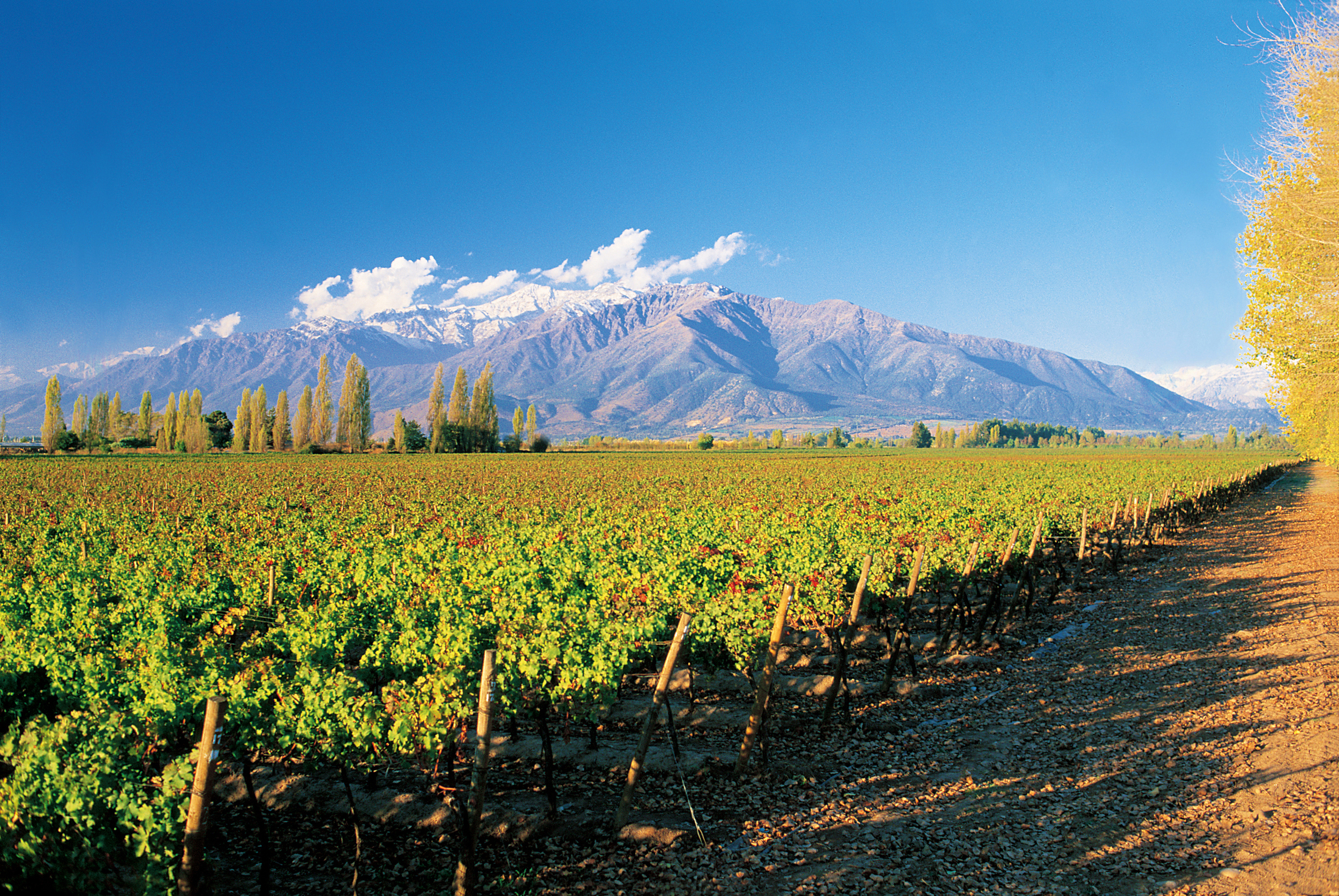 There are moments in history that set a standard and change the game. For the Chilean Wine Industry the launch of Don Melchor was that sea change moment. This super premium Cabernet Sauvignon that can compete with the big boys from any region of the world served notice to wine lovers when it arrived in 1987. That message indicated with clarity that Chile makes a wide range of wines, not only in the value category but in the premium and luxury categories. Since its inaugural vintage Don Melchor has consistently been among the best Cabs in the world. Chile continues to surprise and impress with a breadth of diverse offerings that expands our understanding of the great things they can do there. Don Melchor stays the course and continues to wow. Here’s a look at the 2008 vintage of this wine.
There are moments in history that set a standard and change the game. For the Chilean Wine Industry the launch of Don Melchor was that sea change moment. This super premium Cabernet Sauvignon that can compete with the big boys from any region of the world served notice to wine lovers when it arrived in 1987. That message indicated with clarity that Chile makes a wide range of wines, not only in the value category but in the premium and luxury categories. Since its inaugural vintage Don Melchor has consistently been among the best Cabs in the world. Chile continues to surprise and impress with a breadth of diverse offerings that expands our understanding of the great things they can do there. Don Melchor stays the course and continues to wow. Here’s a look at the 2008 vintage of this wine.
The Concha y Toro 2008 Don Melchor Cabernet Sauvignon was produced from fruit sourced at the Puente Alto Vineyard which is located in the Upper Maipo region of Chile. In addition to Cabernet Sauvignon (97%), there is also some Cabernet Franc (3%) blended in. The fruit was harvested by hand. After fermentation the wine spent 15 months aging in French oak. Don Melchor has a suggested retail price of $95. Cherry, leather and cigar box aromas fill the sexy nose of this 2008 Cabernet Sauvignon. The palate is deeply layered and proportionately intense with cherry, earth and bits of chocolate filling its core. Black pepper spice, minerals and espresso are all present on the finish which is impressively long and persistent. The tannins here are firm but yield with some air. This wine is delicious now but will age gracefully over the next 12-14 years. If you’re going to drink it now, a couple hours in the decanter is recommended.
If you love Cabernet Sauvignon and have yet to experience Don Melchor, it should be on your short list of wines to try. It’s not only one of the best wines from Chile year after year it’s also a benchmark example of Cabernet Sauvignon. Whether you drink it now or lay it down, the 2008 vintage is a fine example of an iconic wine.
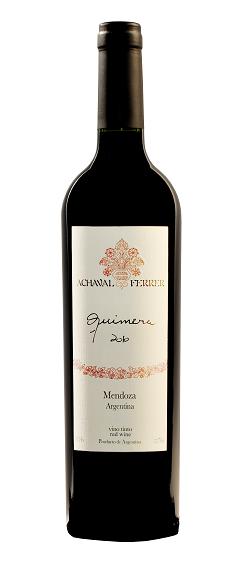 Many wine making regions produce Bordeaux inspired blends and the results vary greatly. In my mind the downfall often comes when trying to mimic the great wines of Bordeaux to the point of not focusing on what does best in the region in question. Argentina of course is best known for Malbec which thrives there in a variety of styles. The latest release from Bodega Achaval-Ferrer is a Bordeaux inspired blend and it’s also a wine with a relatively large percentage of Malbec in it. So here’s a release where Bordeaux inspiration and local rock-star grape meet. Here are my thoughts on the results.
The Achaval-Ferrer 2010 Quimera was produced from fruit sourced in three appellations: Lujan de Cuyo, Medrano, and Tupungato. This offering is a blend of Malbec (31%), Merlot (20%), Cabernet Sauvignon (27%), Cabernet Franc (18%) and Petit Verdot (4%). Each varietal underwent primary fermentation separately in small tanks; Malolactic fermentation followed after the wine was blended. Barrel aging took place over 12 months in entirely French oak; 40% of the barrels utilized were new and the balance had been used once prior. Just more than 3,000 cases of this wine were produced and it has a suggested retail price of $56.
Many wine making regions produce Bordeaux inspired blends and the results vary greatly. In my mind the downfall often comes when trying to mimic the great wines of Bordeaux to the point of not focusing on what does best in the region in question. Argentina of course is best known for Malbec which thrives there in a variety of styles. The latest release from Bodega Achaval-Ferrer is a Bordeaux inspired blend and it’s also a wine with a relatively large percentage of Malbec in it. So here’s a release where Bordeaux inspiration and local rock-star grape meet. Here are my thoughts on the results.
The Achaval-Ferrer 2010 Quimera was produced from fruit sourced in three appellations: Lujan de Cuyo, Medrano, and Tupungato. This offering is a blend of Malbec (31%), Merlot (20%), Cabernet Sauvignon (27%), Cabernet Franc (18%) and Petit Verdot (4%). Each varietal underwent primary fermentation separately in small tanks; Malolactic fermentation followed after the wine was blended. Barrel aging took place over 12 months in entirely French oak; 40% of the barrels utilized were new and the balance had been used once prior. Just more than 3,000 cases of this wine were produced and it has a suggested retail price of $56.
Ripe, red and black fruit aromas fill the heady nose of this 2010 blend from Argentina. The palate is studded with tons of fresh and exuberant fruit flavors; plum, blueberry and blackberry are of particular note. There is depth to spare here, all of the ripe and ready fruit flavors are joined by a notable spice component. The finish is velvety and lingering with pepper, bits of chicory and a dusting of sweet dark chocolate to close things out. The tannins are smooth and lush, pulling you in for sip after mouthwatering sip. There is a load of engaging and eager fruit here that is ready to please now, but there is also structure in place that will allow the 2010 Quimera to age well for a dozen years or more under proper storage conditions.
The goal of great blended wine is to create something that is greater than the sum of its parts. The 2010 Quimera is a seamless mélange of varietals that comes together deliciously to achieve that very goal. And yes while this wine draws some inspiration from Bordeaux it gains as much from the fact that it focuses on what does well in Argentina both in terms of specific grapes and stylistically. This is a wonderful wine that should be on the short list of anyone who loves excellent red blends.
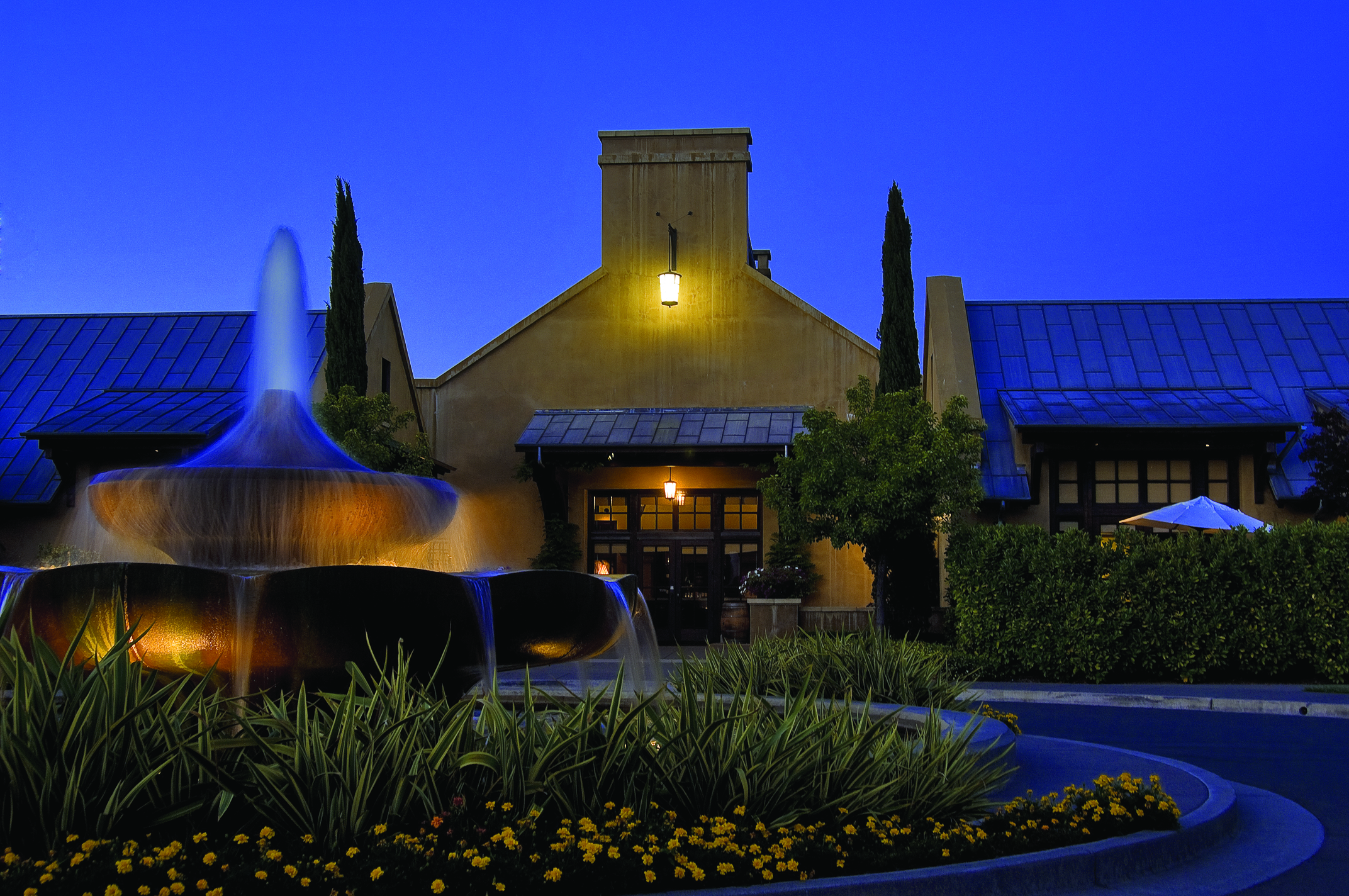 Last week Franciscan Estate threw what amounted to a birthday party, for Magnificat their flagship wine, in Manhattan at Calliope Restaurant. I was glad to be in attendance at this event which showcased the Franciscan Bordeaux blend. Bordeaux blends have been made all over the world for many years, including in Napa. However, it has now been 25 years since the term Meritage was introduced and along with it Franciscan’s first vintage of Magnificat. As such it was a noteworthy milestone to mark, and an excellent reason to take a look at Magnificat alongside some of its peers. Franciscan Winemaker Jay Turnipseed was on hand to speak about his wines as well as to offer some insight in a general sense about all of the Bordeaux inspired wines.
Those peers helped make the event particularly interesting. They were part of a blind tasting of six wines composed of Bordeaux varietals from around the world; Magnificat was of course amongst their number. Tasting them blind was a fine exercise in testing each of our abilities to nail regional characteristics and styles. The sense I got was that most of us gathered had about 2/3 of the regions picked out correctly. All of the blends tasted were from the 2009 vintage. The regions in play were New Zealend, Bordeaux (Left and Right Banks), Walla Walla Washington, South Africa and of course Napa Valley. I was pretty happy getting 4 out of 6 regions correct. The Magnificat stood out to me immediately probably for a few reasons, not the least of which being I’ve been drinking it consistently since the 90’s.
Last week Franciscan Estate threw what amounted to a birthday party, for Magnificat their flagship wine, in Manhattan at Calliope Restaurant. I was glad to be in attendance at this event which showcased the Franciscan Bordeaux blend. Bordeaux blends have been made all over the world for many years, including in Napa. However, it has now been 25 years since the term Meritage was introduced and along with it Franciscan’s first vintage of Magnificat. As such it was a noteworthy milestone to mark, and an excellent reason to take a look at Magnificat alongside some of its peers. Franciscan Winemaker Jay Turnipseed was on hand to speak about his wines as well as to offer some insight in a general sense about all of the Bordeaux inspired wines.
Those peers helped make the event particularly interesting. They were part of a blind tasting of six wines composed of Bordeaux varietals from around the world; Magnificat was of course amongst their number. Tasting them blind was a fine exercise in testing each of our abilities to nail regional characteristics and styles. The sense I got was that most of us gathered had about 2/3 of the regions picked out correctly. All of the blends tasted were from the 2009 vintage. The regions in play were New Zealend, Bordeaux (Left and Right Banks), Walla Walla Washington, South Africa and of course Napa Valley. I was pretty happy getting 4 out of 6 regions correct. The Magnificat stood out to me immediately probably for a few reasons, not the least of which being I’ve been drinking it consistently since the 90’s.
After the blind tasting we sat down to dinner where we were poured several Franciscan wines. This included the current vintage of Magnificat again, side by side with the 2003. The older vintage was actually darker in color that the 2009. Often at about 10 years old the color starts to morph a bit, but this wine was vibrant in color and flavors. While it certainly has a number of years of enjoyable drinking to come, The 2003 Magnificat is in a really lovely place right now. Secondary characteristics have started to kick in and the fruit flavors are ever so slightly tamed. Earth and espresso bean were prominent on the finish.
The current release is the Franciscan Estate 2009 Magnificat. This vintage is a blend of Cabernet Sauvignn (64%), Merlot (26%), Petit Verdot (5%), Cabernet Franc (3%), and Malbec (2%).It was fermented and macerated over a 22 day period. Barrel aging followed over 20 months in French oak; 70% of the barrels were new. Just over 6,000 cases of this wine were produced and it has a suggested retail price of $50. Booming, black fruit aromas emerge from the nose of this wine. The flavors are ripe and eager. Blackberry, raspberry and cherry flavors are all in evidence. There’s dark chocolate and chicory on the lengthy finish along with black pepper and a hint of nutmeg and vanilla bean. The 2009 Magnificat does an excellent job of threading the needle. It’s powerful and elegant at the same time. The flavors are big but never over the top and the tannins firm but not overpowering. In short this is an excellent vintage of Magnificat a wine that is one of the standard bearers of Meritage. It’s delicious today but there’s no need to rush, it will certainly drink well for the next 15 years if stored properly.
Tasting the current vintage of Magnificat alongside counterpart wines from around the world, another vintage of Magnificat and several other Franciscan wines throughout the night really helped showcase its beauty. Happy Birthday Magnificat!
Rodney Strong Vineyards has a large portfolio of wines that crosses many price tiers. Whether you’re looking for an everyday value in the $10 range or site specific wines for a lot more than that, they have them and many in between as well. I continue to be impressed with their reliability across those layers and consider them a go to producer for a variety of wine needs. Here’s a look at two vastly different current releases from them.
 The Rodney Strong Vineyards 2011 Charlotte’s Home Sauvignon Blanc was produced from fruit sourced in Alexander Valley and Russian River Valley. 90% was fermented in temperature controlled stainless steel at low temperatures; the balance in French oak. This widely available wine has a suggested retail price of $15 but can most often be found selling for closer to $11. Lemon ice, white pepper and mineral aromas fill the excitable nose of this 2011 Sauvignon Blanc. Citrus characteristics dominate the palate along with bits of orchard fruit and a gentle hint of pineapple as well. The finish is clean and crisp with mineral and spice notes reverberating well after the last sip has been swallowed. Year after year this wine delivers awesome flavor for a very small price. This is a terrific Sauvignon Blanc for the money and one you can bank on one vintage after another.
The Rodney Strong Vineyards 2011 Charlotte’s Home Sauvignon Blanc was produced from fruit sourced in Alexander Valley and Russian River Valley. 90% was fermented in temperature controlled stainless steel at low temperatures; the balance in French oak. This widely available wine has a suggested retail price of $15 but can most often be found selling for closer to $11. Lemon ice, white pepper and mineral aromas fill the excitable nose of this 2011 Sauvignon Blanc. Citrus characteristics dominate the palate along with bits of orchard fruit and a gentle hint of pineapple as well. The finish is clean and crisp with mineral and spice notes reverberating well after the last sip has been swallowed. Year after year this wine delivers awesome flavor for a very small price. This is a terrific Sauvignon Blanc for the money and one you can bank on one vintage after another.
Rodney Strong Vineyards 2009 Symmetry is a Red Meritage. This selection is a blend of Cabernet Sauvignon (79%), Malbec (14%), Merlot (6%), and Cabernet Franc 1%). Most of the fruit for this wine was sourced in the same Alexander Valley Vineyards that they use for their Single Vineyard Cabernet’s. Barrel aging occurred over 22 months in all French oak. This wine which has been part of the Rodney Strong Portfolio for over 15 years has a suggested retail price of $55. It can often be located for about $45. Red and black raspberry as well as black cherry aromas roar out of the nose of this 2009 Meritage. The palate is loaded with a stunning array of fresh and dry red and black berry fruit flavors that are buoyed by complementary spice notes. The cherry characteristics steal the show here and appear in droves from the first sip to the very last. Earth, chicory, black pepper and sweet dark chocolate notes are all part of the lengthy and harmonious finish. This wine will drink well over the next 8 or so years. However it’s so willing, juicy and ready to give of itself now that there’s simply no reason to wait. This delicious wine is a real pleasure to drink both on its own and paired with hearty foods.
I’m a big fan of Rodney Strong Vineyards and the dependability their wines represent. You can plunk your money down for their offerings with the confidence that you’re going to get value back. Charlotte’s Home Sauvignon Blanc is on my short list of a small handful of California Sauvignon Blanc’s that deliver eminent drinkability, quality and consistency vintage after vintage for a nominal price. Symmetry is precisely what I believe a Meritage wine should be; it seamlessly blends the varietals together to form a whole greater than the sum of its parts. In its price category it also represents a terrific value.
 Terroir is one of those ideas that is thrown around a lot as a buzz word in the wine industry. Depending on who it is bringing it up there can be a bit of controversy surrounding it. And while it may seem a little out there to some folks to think that Cabernet Sauvignon for example planted in a specific spot can be imbued with very different characteristics than a Cabernet Sauvignon planted a few hundred feet away, the truth is in the bottle. All one really needs to better understand the concept of Terroir is a taste, once you’ve experienced it first hand it’s easier to believe. Of course it’s a sliding scale and not every wine or more specifically every place will impart that. Furthermore some wines are made in such a style that their Terroir ends up being masked. That’s a different part of the subject for another day. This is about wines that do show their sense of place. I attended Vinos De Terroir hosted by Wines of Chile. The concept was a focused look at 10 great examples of Terroir driven wines from Chile. The event took place at Colicchio & Sons, hosted by Pedro Parra PhD and Terroir expert, author Mark Oldman and Sandy Block Master of Wine. Over the course of a couple of hours we took a long hard look at 10 wines in a classroom style format. After that we sat down for lunch and the same 10 wines were available to taste with our meal. These wines were uniformly excellent examples of Terroir. What follows are some reflections on the ones that were my personal favorites.
The one white wine from this particular tasting was the Casa Marín 2011 Cipress Vineyard Sauvignon Blanc. This is a 100% Varietal wine sourced from a vineyard at the very top of a hillside. The fruit came from 6 blocks within this specific vineyard. It sits 4 km from the ocean and is one of the most extreme plantings in all of Chile. The conditions are very windy and result in low yields. This wine has a suggested retail price of $28. There’s a huge burst of lemon characteristics that explode from this Sauvignon Blanc. They’re joined by bits of green herb to form a pleasing nose. Citrus, tropical fruits and lots of mineral notes are all part of the complex and layered palate which has excellent weight. Lemon curd, bits of candied tropical fruits and a bevy of spice notes are part of the persistent finish. This Sauvignon Blanc is a real knockout, impressive in every way. It’s well worth making a special effort to locate. I can't overstate how phenomenal this Sauvignon Blanc is, grab some and taste its excellence for yourself.
Terroir is one of those ideas that is thrown around a lot as a buzz word in the wine industry. Depending on who it is bringing it up there can be a bit of controversy surrounding it. And while it may seem a little out there to some folks to think that Cabernet Sauvignon for example planted in a specific spot can be imbued with very different characteristics than a Cabernet Sauvignon planted a few hundred feet away, the truth is in the bottle. All one really needs to better understand the concept of Terroir is a taste, once you’ve experienced it first hand it’s easier to believe. Of course it’s a sliding scale and not every wine or more specifically every place will impart that. Furthermore some wines are made in such a style that their Terroir ends up being masked. That’s a different part of the subject for another day. This is about wines that do show their sense of place. I attended Vinos De Terroir hosted by Wines of Chile. The concept was a focused look at 10 great examples of Terroir driven wines from Chile. The event took place at Colicchio & Sons, hosted by Pedro Parra PhD and Terroir expert, author Mark Oldman and Sandy Block Master of Wine. Over the course of a couple of hours we took a long hard look at 10 wines in a classroom style format. After that we sat down for lunch and the same 10 wines were available to taste with our meal. These wines were uniformly excellent examples of Terroir. What follows are some reflections on the ones that were my personal favorites.
The one white wine from this particular tasting was the Casa Marín 2011 Cipress Vineyard Sauvignon Blanc. This is a 100% Varietal wine sourced from a vineyard at the very top of a hillside. The fruit came from 6 blocks within this specific vineyard. It sits 4 km from the ocean and is one of the most extreme plantings in all of Chile. The conditions are very windy and result in low yields. This wine has a suggested retail price of $28. There’s a huge burst of lemon characteristics that explode from this Sauvignon Blanc. They’re joined by bits of green herb to form a pleasing nose. Citrus, tropical fruits and lots of mineral notes are all part of the complex and layered palate which has excellent weight. Lemon curd, bits of candied tropical fruits and a bevy of spice notes are part of the persistent finish. This Sauvignon Blanc is a real knockout, impressive in every way. It’s well worth making a special effort to locate. I can't overstate how phenomenal this Sauvignon Blanc is, grab some and taste its excellence for yourself.
Concha y Toro’s 2008 Carmín de Peumo is a blend of primarily Carménère (90%), with Cabernet Sauvignon (7.5%) and Cabernet Franc (2.5%) blended in. The vineyard this fruit was sourced from has river bench soils with alluvial clay loams. It’s a cool area that promotes a long growing season. The wine was aged for 18 months in 100% new French oak. This offering has a suggested retail price of $150. Bits of green herb emerge from the nose of this wine along with red and black fruit aromas. Blackberry and cherry flavors are in strong evidence on the palate along with spices to spare, and minerals aplenty. The finish is tremendously pleasing and impressive in length and perseverance; sour black fruits, hints of smoked meat and continued spice and mineral notes all play a role. This is an impeccably balanced example of Carménère that shows off oodles of eager fruit as well as the wisps of green herb that are part of this varietal when it’s well made. When Carménère isn’t properly grown or handled it goes too far in one direction or the other. This wine sits perfectly in the middle. Carmín de Peumo is a stunning and world class example of a varietal that’s on the rise.
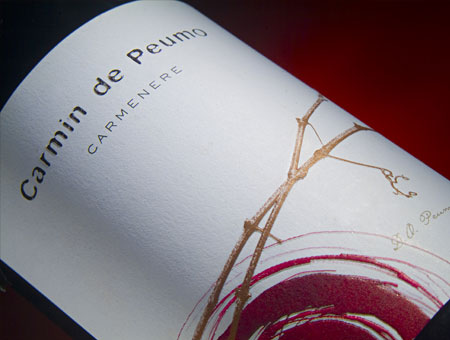 Lapostolle’s 2009 Clos Apalta is a blend of Carménère (78%), Cabernet Sauvignon (19%), and Petit Verdot (3%). The fruit for this selection came from hillside vineyards in Apalta that feature diverse soils. Aging occurred in entirely new French oak over a period of 24 months. This wine has a suggested retail price of $90. The 2009 Clos Apalta has a nose loaded with mission figs and plums with bits of red fruit interspersed as well. The juicy and willing palate is absolutely studded with velvety, dark fruit flavors, savory spices and bits of graphite. There is tremendous depth here from the first sip to the last impression this wine leaves. Fruit, spice, minerals and bits of earth reverberate for a long while after the last bit has been swallowed. This has been one of the benchmark wines of Chile for a number of years now. The 2009 vintage simply continues that reputation forward and proves again that it’s a well deserved one. If you have never tasted Clos Apalta before you owe it to yourself to do so; the 2009 vintage is as good a jumping off point as any.
Lapostolle’s 2009 Clos Apalta is a blend of Carménère (78%), Cabernet Sauvignon (19%), and Petit Verdot (3%). The fruit for this selection came from hillside vineyards in Apalta that feature diverse soils. Aging occurred in entirely new French oak over a period of 24 months. This wine has a suggested retail price of $90. The 2009 Clos Apalta has a nose loaded with mission figs and plums with bits of red fruit interspersed as well. The juicy and willing palate is absolutely studded with velvety, dark fruit flavors, savory spices and bits of graphite. There is tremendous depth here from the first sip to the last impression this wine leaves. Fruit, spice, minerals and bits of earth reverberate for a long while after the last bit has been swallowed. This has been one of the benchmark wines of Chile for a number of years now. The 2009 vintage simply continues that reputation forward and proves again that it’s a well deserved one. If you have never tasted Clos Apalta before you owe it to yourself to do so; the 2009 vintage is as good a jumping off point as any.
Finally we have the Montes 2009 Folly. This is a 100% Syrah wine. The fruit for this wine came from the highest slopes of the La Finca de Apalta vineyard. Aging of this wine occurred over 18 months in New French oak. The suggested retail price is $90. Dark fruit aromas gush from the nose of this Syrah with stunning conviction. Blackberry and plum flavors dominate the palate along with minerals, spice, coffee, chocolate sauce and more. The finish shows off dusty cocoa as well as continued spice and dark fruit flavors. This is a wonderful example of Syrah that is delicious today but will benefit from a couple of years of bottle age. It will work particularly well paired with full flavored foods.
There are two things exhibited by this quartet of wines as well as the others tasted alongside them. First is the fact that terroir does matter and it is being utilized in Chile to make wonderful site specific wines. Second, these wines underscore the notion that Chile is producing wines at a wide array of levels, including offerings that can compete with the best in the world. The bottom line is whatever sort of wine you’re looking to drink and regardless of how much money you want to spend, Chile should be on your radar.
 My recent trip to Chile was impressive on a number of different levels. One thing that stood out to me in particular was the diversity of the winery properties we got to visit. They ranged in size, scope and style. One of the more beautiful and historic was Santa Rita. The property there is simply gorgeous. Beautiful gardens within large expanses of property, a chapel, historic hotel and an authentic restaurant and more come together to form a wonderful destination for wine lovers as well as anyone who enjoys a beautiful slice of the earth. They offer a diversity of touring and tasting options that should appeal to visitors of all sots. Check their website for specific details.
While at Santa Rita we toured the property and facility, had lunch at Doña Paula their onsite Restaurant; most importantly however we tasted through the portfolio. As is common in Chile Santa Rita has several tiers of wines. Their entry level wines start at around $9 dollars and their top shelf selection runs around $75; in between are a host of selections in various prices with varying styles, intents and palates in mind. In total we tasted through 15 selections during our formal sit down tasting, what follows are my impressions of a handful of my personal favorites from that day.
My recent trip to Chile was impressive on a number of different levels. One thing that stood out to me in particular was the diversity of the winery properties we got to visit. They ranged in size, scope and style. One of the more beautiful and historic was Santa Rita. The property there is simply gorgeous. Beautiful gardens within large expanses of property, a chapel, historic hotel and an authentic restaurant and more come together to form a wonderful destination for wine lovers as well as anyone who enjoys a beautiful slice of the earth. They offer a diversity of touring and tasting options that should appeal to visitors of all sots. Check their website for specific details.
While at Santa Rita we toured the property and facility, had lunch at Doña Paula their onsite Restaurant; most importantly however we tasted through the portfolio. As is common in Chile Santa Rita has several tiers of wines. Their entry level wines start at around $9 dollars and their top shelf selection runs around $75; in between are a host of selections in various prices with varying styles, intents and palates in mind. In total we tasted through 15 selections during our formal sit down tasting, what follows are my impressions of a handful of my personal favorites from that day.
Santa Rita 2011 Reserva Sauvignon Blanc D.O Casablanca Valley: This is a 100% varietal wine made from estate fruit. The cool climate of Casablanca is one of several areas in Chile that are particularly well suited for this grape. The Reserva tier of wines has a suggested retail price of $12.99. Pineapple aromas and flavors are apparent throughout this wine which has a lovely nose and medium weight palate. Pear and citrus flavors play a role as well. This wine has a crisp finish and zippy acidity. All three Sauvignon Blanc’s we sampled were well made and appealing. However I found this one to be the knockout value of the trio.
Santa Rita 2009 Reserva Malbec D.O. Colchagua Valley: This release is a blend of primarily Malbec (85%) with a healthy dollop of Merlot (15%) blended in. This wine was aged in American and French oak barrels for approximately 8 months. It has a suggested retail price of $12.99. This is a classically styled Malbec where black fruit aromas and flavors dominate. The palate is layered and persistent with plum and raspberry flavors. Hints of espresso emerge on the finish along with copious spices. The tannins are chewy and substantial but yield with some air. This is an excellent Malbec that has plenty of willing fruit flavors but also isn’t overwrought in any way. For the money this is an outright steal that may just completely change your view of the quality of under $15 Malbec forever.
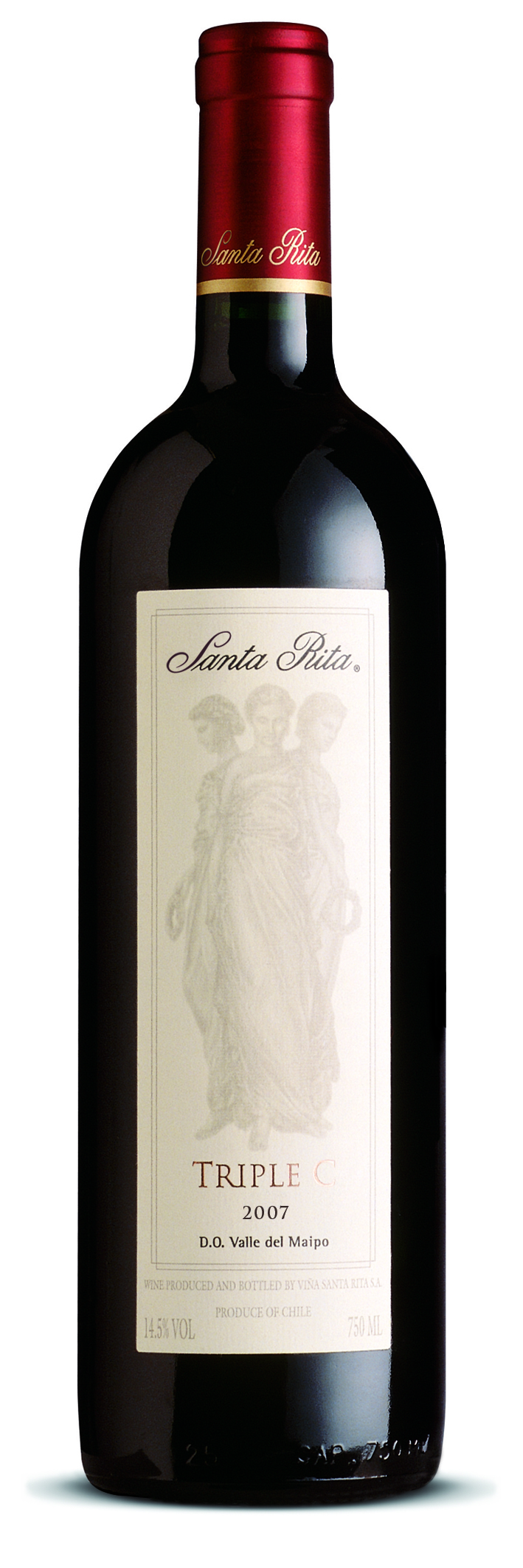 Santa Rita 2009 Medalla Real Cabernet Sauvignon D.O. Maipo Valley: This wine is predominately Cabernet Sauvignon (95%) with a touch of Cabernet Franc (5%) blended in. The vines utilized have 15 years of age on them. Barrel aging occurred over 14 months in a combination of 1st, 2nd and 3rd use oak. The Medalla Real range of wines has a suggested retail price of $19.99. This wine has a classic Cabernet Sauvignon nose of red and black berries laced with hints of toast and wisps of vanilla bean. Boatloads of cherry flavors dominate the palate and lead to pomegranate characteristics on the finish along with earth and black pepper. This is a remarkable Cabernet Sauvignon for under $20. A Cabernet of this quality, depth and persistence from Napa Valley to use one point of comparison would easily fetch $35-$40.
Santa Rita 2009 Medalla Real Cabernet Sauvignon D.O. Maipo Valley: This wine is predominately Cabernet Sauvignon (95%) with a touch of Cabernet Franc (5%) blended in. The vines utilized have 15 years of age on them. Barrel aging occurred over 14 months in a combination of 1st, 2nd and 3rd use oak. The Medalla Real range of wines has a suggested retail price of $19.99. This wine has a classic Cabernet Sauvignon nose of red and black berries laced with hints of toast and wisps of vanilla bean. Boatloads of cherry flavors dominate the palate and lead to pomegranate characteristics on the finish along with earth and black pepper. This is a remarkable Cabernet Sauvignon for under $20. A Cabernet of this quality, depth and persistence from Napa Valley to use one point of comparison would easily fetch $35-$40.
Santa Rita 2007 Triple C, D.O. Maipo Valley: This offering is a blend of Cabernet Franc (65%), Cabernet Sauvignon (30%), and Carménère (5%). The Carménère vines utilized have more than 70 years of age on them. Barrel aging took place over 20 months in new French oak. This wine has a suggested retail price of $35. Triple C is lead by an explosive nose loaded with cherries, leather and violets. Throughout the complex palate cherry flavors continue to dominate the show, Pencil lead, earth and spices reverberate throughout the lengthy finish. Firm but yielding tannins mark this wines impressive structure. This blend is a bit on the young side now, but oh so delicious and impressive. For it to really shine it needs a couple of years in the cellar or 2-3 hours in the decanter. In any case it’s a lovely blend that it sure to impress. This is one of a number of wines I tasted on my trip to Chile that indicate with confidence that Blends will be the key to Chile’s rise in the wine world over the next few years.
This tasty quartet of wines represents the tip of the iceberg when it comes to the Santa Rita portfolio. What I had the opportunity to taste was a well made array of wines whose tiers are well defined. Sometimes tasting 3 or 4 examples of one varietal from a single winery leaves me shaking my head. That’s because they are often far too similar because a house style has prevailed over letting the fruit speak. This was most definitely not the case at Santa Rita. Tasting these wines side by side the distinction between vineyards, range and stylistic choices guided by the winemakers was clear. I urge you to try a wine from Santa Rita in a price range you’re comfortable with and them dabble in various directions after you discover what I did: how well made, delicious and value driven their wines are regardless of price-point. And if you're in Chile, make Santa Rita one of your destinations.









